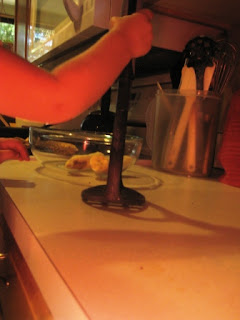Everybody knows real food is a great idea, but one of the biggest obstacles most people face is that processed food is SO convenient - it's always there, no matter the season, predictable and never-changing. But real food comes in seasons. You can't (or maybe shouldn't) eat fresh strawberries in December.
That's why I love my freezer! If you opened my freezer right now (it's October), you would find containers full of strawberries and blueberries that I picked this summer. They are obviously not as fun as fresh, but there's something decadent about a strawberry in the middle of the winter. *
But you can't just throw a bowl of strawberries in the freezer and hope for good results!
To freeze fruits and veggies quickly and easily, do these 4 things:
1. Find a cookie sheet or quarter sheet-pan that will fit in your freezer.
2. Line the cookie sheet with parchment or waxed paper
3. Spread fruit or vegetable in a SINGLE LAYER on the waxed paper.
4. Place in freezer for a few hours.
Yes. It really is that easy. But it's magical: the SINGLE LAYER of fruit or veggie means when it's time to transfer your produce to more permanent freezer storage, each berry or grape or carrot slice will come off the pan without sticking to all the others! This way, you don't end up with a giant boulder of frozen fruit that you have to break before using!
Storage Tip: in the past I've used Zip-type bags, but since I'm trying to move away from so much disposable plastic, I now use inexpensive lidded plastic pitchers.
Long Term Storage Tip: Some veggies contain enzymes that may make the produce mushy or discolored if it is going to be frozen for a long time. For example, if you flash freeze corn as described above, after a few weeks, they will become softer. But I have never had this problem with berries! If you are planning on keeping frozen vegetables in the freezer for many months, you may want to steam blanch them first to deactivate those pesky enzymes. Then you can use this single-layer flash-freezing method just as described!
* I know some hard-core preppers or even permaculturists might call me out on this: "Freezers use so much energy." "If you can those strawberries, you can keep them at room temperature." "If the SHTF, your frozen strawberries won't last long," sniggering behind their hands as they stockpile fake dried cheese.
And you know what? They're right. People have been living happily without frozen strawberries for thousands of years. But I'm a big proponent of Jack Spirko's "Law of Prepping:" Everything you do to prepare for the future should benefit you in the future, but it should also benefit you RIGHT NOW!
And right now, I want to pick lots of local organic strawberries in June, and I want to have some to give to my kids in October when the skies are gray and cloudy and we all need a little Vitamin C. Our current lifestyle provides us with a freezer, so I'm going to darn well use it. A full freezer is an efficient freezer anyway.




























